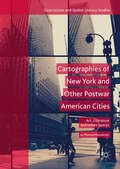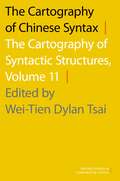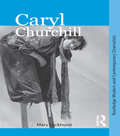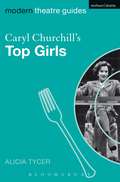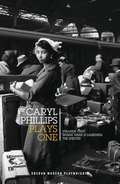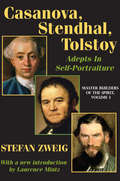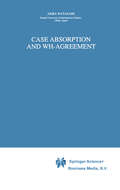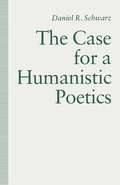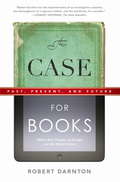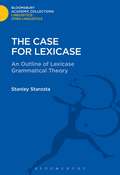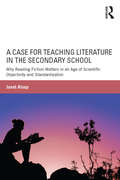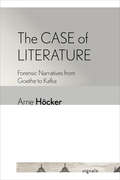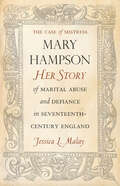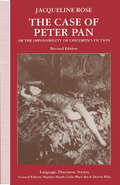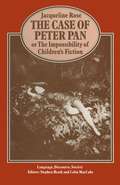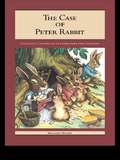- Table View
- List View
Cartographies of New York and Other Postwar American Cities: Art, Literature and Urban Spaces (Geocriticism and Spatial Literary Studies)
by Monica ManolescuCartographies of New York and Other Postwar American Cities: Art, Literature and Urban Spaces explores phenomena of urban mapping in the discourses and strategies of a variety of postwar artists and practitioners of space: Allan Kaprow, Claes Oldenburg, Vito Acconci, Gordon Matta-Clark, Robert Smithson, Rebecca Solnit, Matthew Buckingham, contemporary Situationist projects. The distinctive approach of the book highlights the interplay between texts and site-oriented practices, which have often been treated separately in critical discussions. Monica Manolescu considers spatial investigations that engage with the historical and social conditions of the urban environment and reflect on its mediated nature. Cartographic procedures that involve walking and surveying are interpreted as unsettling and subversive possibilities of representing and navigating the postwar American city. The book posits mapping as a critical nexus that opens up new ways of studying some of the most important postwar artistic engagements with New York and other American cities.
Cartography and Explanatory Adequacy (Oxford Studies in Theoretical Linguistics #85)
This book contributes to the ongoing empirical, conceptual, and meta-theoretical debates regarding the merits and drawbacks of the cartographic program in linguistic theory. Although cartography has its roots in the study of the left periphery, its empirical scope has expanded significantly over the years and now covers a wide range of domains such as argument structure, modification, and constituent order. The chapters in this volume offer a critical examination of the cartographic assumption that there is a rich array of functional projections whose hierarchical order is fixed and determined by Universal Grammar. They discuss the nature of these cartographic hierarchies and their relation to the central theoretical goal of explanatory adequacy: are functional hierarchies an irreducible property of Universal Grammar (hence constituting part of the "residue" beyond the scope of principled explanation), or are they emergent, deriving from independent principles that do not require a further enrichment of Universal Grammar?
The Cartography of Chinese Syntax: The Cartography of Syntactic Structures, Volume 11 (Oxford Studies in Comparative Syntax)
This edited volume provides new insights into the architecture of Chinese grammar from a comparative perspective, using principles of cartography. Cartography is a research program within syntactic theory that is guided by the view that syntactic structures contain grammatical and functional information that is ideal for semantic interpretation - by studying the syntactic structures of a particular language, syntacticians can better understand the semantic issues at play in that language. The chapters in this book map out the "topography" of a variety of constructions in Chinese, specifically information structure, wh-question formation, and peripheral functional elements. The syntactic structure of Chinese makes it an ideal language for this line of research, because functional elements are often spread throughout sentences rather than clumped together as is usually dictated by language-specific morphology. Mapping Chinese syntactic structures therefore offers a window into the origin of heavily "scrambled" constructions often observed in other languages. The book includes a preface that will discusses the goal of cartography and explains how the collection contributes towards our understanding of this approach to syntax. The subsequent seven original articles all contain original syntactic data that is invaluable for future research in cartography, and the collection as a whole paints a broader picture of how the alignment between syntax and semantics works in a principled way.
Caryl Churchill (Routledge Modern and Contemporary Dramatists)
by Mary LuckhurstOne of Europe's greatest playwrights, Caryl Churchill has been internationally celebrated for four decades. She has exploded the narrow definitions of political theatre to write consistently hard-edged and innovative work. Always unpredictable in her stage experiments, her plays have stretched the relationships between form and content, actor and spectator to their limits. This new critical introduction to Churchill examines her political agendas, her collaborations with other practitioners, and looks at specific production histories of her plays. Churchill's work continues to have profound resonances with her audiences and this book explores her preoccupation with representing such phenomena as capitalism, genocide, environmental issues, identity, psychiatry and mental illness, parenting, violence and terrorism. It includes new interviews with actors and directors of her work, and gathers together source material from her wide-ranging career.
Caryl Churchill (Routledge Modern and Contemporary Dramatists)
by Mary LuckhurstOne of Europe's greatest playwrights, Caryl Churchill has been internationally celebrated for four decades. She has exploded the narrow definitions of political theatre to write consistently hard-edged and innovative work. Always unpredictable in her stage experiments, her plays have stretched the relationships between form and content, actor and spectator to their limits. This new critical introduction to Churchill examines her political agendas, her collaborations with other practitioners, and looks at specific production histories of her plays. Churchill's work continues to have profound resonances with her audiences and this book explores her preoccupation with representing such phenomena as capitalism, genocide, environmental issues, identity, psychiatry and mental illness, parenting, violence and terrorism. It includes new interviews with actors and directors of her work, and gathers together source material from her wide-ranging career.
Caryl Churchill's Top Girls (Modern Theatre Guides)
by Alicia TycerCaryl Churchill is widely considered to be one of the most innovative playwrights to haveemerged in post-war British theatre. Identified as a socialist feminist writer, she is one of the few British women playwrights to have been incorporated into the dramatic canon. Top Girls is one of Churchill's most well known and often studied works, using an all female cast to critique bourgeois feminism during the Thatcher era.
Caryl Churchill's Top Girls (Modern Theatre Guides)
by Alicia TycerCaryl Churchill is widely considered to be one of the most innovative playwrights to haveemerged in post-war British theatre. Identified as a socialist feminist writer, she is one of the few British women playwrights to have been incorporated into the dramatic canon. Top Girls is one of Churchill's most well known and often studied works, using an all female cast to critique bourgeois feminism during the Thatcher era.
Caryl Phillips: Strange Fruit / Where There is Darkness / The Shelter (Oberon Modern Plays)
by Caryl PhillipsThree plays by playwright and novelist Caryl Phillips, written in the 1980s and collected here for the first time. Strange Fruit is a powerful study of a black family caught between two cultures; Where There is Darkness examines the plight of a West Indian man, Albert Williams, on the eve of his return to the Caribbean after an absence of twenty-five years; The Shelter alternates between the late eighteenth-century and 1950s London, exploring the relationship between a black man and a white woman.
Caryl Phillips, David Dabydeen and Fred D'Aguiar: Representations of slavery (Contemporary World Writers)
by Abigail WardSlavery is a recurring subject in works by the contemporary black writers in Britain Caryl Phillips, David Dabydeen and Fred D’Aguiar, yet their return to this past arises from an urgent need to understand the racial anxieties of twentieth- and twenty-first-century Britain. This book examines the ways in which their literary explorations of slavery may shed light on current issues in Britain today, or what might be thought of as the continuing legacies of the UK’s largely forgotten slave past.In this highly original study of contemporary postcolonial literature, Abigail Ward explores a range of novels, poetry and non-fictional works by these authors in order to investigate their creative responses to the slave past. This is the first study to focus exclusively on British literary representations of slavery, and thoughtfully engages with such notions as the ethics of exploring slavery, the memory and trauma of this past, and the problems of taking a purely historical approach to Britain’s involvement in slavery or Indian indenture. Although all three authors are concerned with the problem of how to commence representing slavery, their approaches to this problem vary immensely, and this book investigates these differences.
Casanova, Stendhal, Tolstoy: Volume 3, Master Builders of the Spirit
by Jay KatzCasanova, Stendhal, Tolstoy: Adepts in Self-Portraiture, the final volume of Stefan Zweig's masterful Master Builders of the Spirit trilogy, discloses the smaller version of a writer's own ego. Unconscious though it is, no reality is as important to the writer as the reality of their own life. Giacomo Casanova, Stendhal (Marie-Henri Beyle), and Leo Tolstoy have different approaches to self-portraiture, but Zweig shows that together they symbolize three levels which represent successively ascending gradations of the same creative function.Casanova is depicted as having a primitive gradation; he simply records deeds and happenings, without any attempt to appraise them or to study the deeper working of the self. Stendhal's self-portraiture is depicted as psychological; he observes himself and investigates his own feelings. Tolstoy has the highest level; he describes his own life, records what led him to his own actions, and focuses on self-reflection in a completely unexaggerated manner.At first glance it might seem as if self-portraiture is an artist's easiest task. With no further trouble than a probing of memory and a description of the facts of life, "the truth" is revealed. The history of literature shows that ordinary autobiographers are no more than commonplace witnesses testifying to facts that chance has brought to their knowledge. A practiced artist is needed to discern the innermost happenings of the soul; few who have attempted autobiography have been successful in this difficult task. The present volume expounds the characteristics of these subjectively minded artists, and of autobiography as their typical method of personal expression.
Casanova, Stendhal, Tolstoy: Volume 3, Master Builders of the Spirit
by Jay KatzCasanova, Stendhal, Tolstoy: Adepts in Self-Portraiture, the final volume of Stefan Zweig's masterful Master Builders of the Spirit trilogy, discloses the smaller version of a writer's own ego. Unconscious though it is, no reality is as important to the writer as the reality of their own life. Giacomo Casanova, Stendhal (Marie-Henri Beyle), and Leo Tolstoy have different approaches to self-portraiture, but Zweig shows that together they symbolize three levels which represent successively ascending gradations of the same creative function.Casanova is depicted as having a primitive gradation; he simply records deeds and happenings, without any attempt to appraise them or to study the deeper working of the self. Stendhal's self-portraiture is depicted as psychological; he observes himself and investigates his own feelings. Tolstoy has the highest level; he describes his own life, records what led him to his own actions, and focuses on self-reflection in a completely unexaggerated manner.At first glance it might seem as if self-portraiture is an artist's easiest task. With no further trouble than a probing of memory and a description of the facts of life, "the truth" is revealed. The history of literature shows that ordinary autobiographers are no more than commonplace witnesses testifying to facts that chance has brought to their knowledge. A practiced artist is needed to discern the innermost happenings of the soul; few who have attempted autobiography have been successful in this difficult task. The present volume expounds the characteristics of these subjectively minded artists, and of autobiography as their typical method of personal expression.
Case Absorption and WH-Agreement (Studies in Natural Language and Linguistic Theory #37)
by A. WatanabeThis book is an extensively revised version of the core part of my 1993 MIT doctoral dissertation, which seeks to provide a Minimalist theory of Case absorption and support it through empirical investigation. The central idea pursued is that impoverishment of phrase structure is responsible for Case absorption and that the right theory of Case checking should derive this property. Although the basic line of research on Case absorption and wh-agreement remains the same, this book incorporates a lot of new results. A principied theory of Case checking and Case absorption has been worked out in Chapter 1. Treatment of participial constructions in Chapter 3 and wh agreement in Chapter 4 is far more systematic and comprehensive. Chapter 2 is also streamlined, together with refinements of the analysis of Romanian. The product, I hope, is a more convincing def ense of the strength of the Mi ni mal ist approach. I would like to thank my thesis committee members Ken Haie, Noam Chomsky, and Howard Lasnik, under whose guidance this project started.
Case and Linking in Language Comprehension: Evidence from German (Studies in Theoretical Psycholinguistics #34)
by Markus Bader Josef BayerThe Case For a Humanistic Poetics
by Daniel R. SchwarzAn attempt to define a humanistic and pluralistic ideology of reading which takes recent theory into account. By the same author as "The Humanistic Heritage: Critical Theories on the English Novel from James through Hillis Miller", and "Reading Joyce's `Ulysses'".
The Case for Books: Past, Present, and Future
by Robert DarntonThe era of the printed book is at a crossroad. E-readers are flooding the market, books are available to read on cell phones, and companies such as Google, Amazon, and Apple are competing to command near monopolistic positions as sellers and dispensers of digital information. Already, more books have been scanned and digitized than were housed in the great library in Alexandria. Is the printed book resilient enough to survive the digital revolution, or will it become obsolete? In this lasting collection of essays, Robert Darnton-an intellectual pioneer in the field of this history of the book-lends unique authority to the life, role, and legacy of the book in society.
The Case for Books: Past, Present, and Future
by Robert DarntonThe invention of writing was one of the most important technological, cultural, and sociological breakthroughs in human history. With the printed book, information and ideas could disseminate more widely and effectively than ever before -- and in some cases, affect and redirect the sway of history. Today, nearly one million books are published each year. But is the era of the book as we know it -- a codex of bound pages -- coming to an end? And if it is, should we celebrate its demise and the creation of a democratic digital future, or mourn an irreplaceable loss? The digital age is revolutionizing the information landscape. Already, more books have been scanned and digitized than were housed in the great library in Alexandria, making available millions of texts for a curious reader at the click of a button, and electronic book sales are growing exponentially. Will this revolution in the delivery of information and entertainment make for more transparent and far-reaching dissemination or create a monopolistic stranglehold? In The Case for Books, Robert Darnton, an intellectual pioneer in the field of the history of the book and director of Harvard University's Library, offers an in-depth examination of the book from its earliest beginnings to its shifting role today in popular culture, commerce, and the academy. As an author, editorial advisor, and publishing entrepreneur, Darnton is a unique authority on the life and role of the book in society. This book is a wise work of scholarship -- one that requires readers to carefully consider how the digital revolution will broadly affect the marketplace of ideas.
The Case for Critical Literacy: A History of Reading in Writing Studies
by Alice S. HorningThe Case for Critical Literacy explores the history of reading within writing studies and lays the foundation for understanding the impact of this critical, yet often untaught, skill. Every measure of students’ reading comprehension, whether digital or analog, demonstrates that between 50 and 80 percent of students are unable to capture the substance of a full discussion or evaluate material for authority, accuracy, currency, relevancy, appropriateness, and bias. This book examines how college-level instruction reached this point and provides pedagogical strategies that writing instructors and teachers can use to address the problem. Alice Horning makes the case for the importance of critical reading in the teaching of writing with intentionality and imagination, while sharing glimpses of her own personal history with reading and writing. Horning provides the context for understanding what college faculty face in their classrooms and offers a history of critical literacy that explains why, to date, it has mostly neglected or ignored the diverse statuses of students’ reading challenges. The Case for Critical Literacy explores actionable options to better meet students’ literacy needs. College and university faculty, especially writing instructors, will benefit from an understanding of what has happened in the field and what needs to change.
The Case for Lexicase (Linguistics: Bloomsbury Academic Collections)
by Stanley StarostaStarosta describes the formal properties of lexicase theory and its historical and metatheoretical relations to other current grammatical frameworks. He argues that it is preferable to other grammatical frameworks, as it is constrained enough to have empirical content, simple enough to be tested and applied to enough languages to have a plausible claim to universality. Examples are drawn from English and various Asian, Pacific, Australian, and African languages.
A Case for Teaching Literature in the Secondary School: Why Reading Fiction Matters in an Age of Scientific Objectivity and Standardization
by Janet AlsupTaking a close look at the forces that affect English education in schools—at the ways literature, cognitive science, the privileging of the STEM disciplines, and current educational policies are connected—this timely book counters with a strong argument for the importance of continuing to teach literature in middle and secondary classrooms. The case is made through critical examination of the ongoing "culture wars" between the humanities and the sciences, recent research in cognitive literary studies demonstrating the power of narrative reading, and an analysis of educational trends that have marginalized literature teaching in the U.S., including standards-based and scripted curricula. The book is distinctive in presenting both a synthesis of arguments for literary study in the middle and high school and sample lesson plans from practicing teachers exemplifying how literature can positively influence adolescents’ intellectual, emotional, and social selves.
A Case for Teaching Literature in the Secondary School: Why Reading Fiction Matters in an Age of Scientific Objectivity and Standardization
by Janet AlsupTaking a close look at the forces that affect English education in schools—at the ways literature, cognitive science, the privileging of the STEM disciplines, and current educational policies are connected—this timely book counters with a strong argument for the importance of continuing to teach literature in middle and secondary classrooms. The case is made through critical examination of the ongoing "culture wars" between the humanities and the sciences, recent research in cognitive literary studies demonstrating the power of narrative reading, and an analysis of educational trends that have marginalized literature teaching in the U.S., including standards-based and scripted curricula. The book is distinctive in presenting both a synthesis of arguments for literary study in the middle and high school and sample lesson plans from practicing teachers exemplifying how literature can positively influence adolescents’ intellectual, emotional, and social selves.
The Case of Literature: Forensic Narratives from Goethe to Kafka (Signale: Modern German Letters, Cultures, and Thought)
by Arne HöckerIn The Case of Literature, Arne Höcker offers a radical reassessment of the modern European literary canon. His reinterpretations of Goethe, Schiller, Büchner, Döblin, Musil, and Kafka show how literary and scientific narratives have determined each other over the past three centuries, and he argues that modern literature not only contributed to the development of the human sciences but also established itself as the privileged medium for a modern style of case-based reasoning.The Case of Literature deftly traces the role of narrative fiction in relation to the scientific knowledge of the individual from eighteenth-century psychology and pedagogy to nineteenth-century sexology and criminology to twentieth-century psychoanalysis. Höcker demonstrates how modern authors consciously engaged casuistic forms of writing to arrive at new understandings of literary discourse that correspond to major historical transformations in the function of fiction. He argues for the centrality of literature to changes in the conceptions of psychological knowledge production around 1800; legal responsibility and institutionalized forms of decision-making throughout the nineteenth century; and literature's own realist demands in the early twentieth century.
The Case of Mistress Mary Hampson: Her Story of Marital Abuse and Defiance in Seventeenth-Century England
by Jessica MalayThe centerpiece of The Case of Mistress Mary Hampson is the autobiographical narrative of a 17th-century woman in an abusive and violent marriage. Composed at a time when marital disharmony was in vogue with readers and publishers, it stands out from comparable works, usually single broadsheets. In her own words, Mary recounts various dramatic and stressful episodes from her decades-long marriage to Robert Hampson and her strategies for dealing with it. The harrowing tale contains scenes of physical abuse, mob violence, abandonment, flight, and destitution. It also shows moments of personal courage and interventions on the author's behalf by friends and strangers, some of whom are subject to severe reprisals. Mary wrote her story to come to terms with her situation, to justify her actions, and to cast herself in a virtuous light. The accompanying discussion of her life, drawn from other sources, provides chilling evidence of the vulnerability of seventeenth-century women and the flawed legal mechanisms that were supposed to protect them. Readers are also invited to consider in what ways the self-portrait is accurate and what elements of it may be considered fabrication. Malay's archival efforts have thus rescued a compelling and complicated voice from the past.
The Case of Peter Pan: or The Impossibility of Children's Fiction (Language, Discourse, Society)
by Jacqueline RoseWhat does Peter Pan have to say about our conception of childhood, about how we understand the child's and our own relationship to language, sexuality, and death? What can Peter Pan tell us about the theatrical, literary, and educational institutions of which it is a part? In a new preface written especially for this edition, Rose accounts for some of the new developments since her book's first publication in 1984. She discusses some of Peter Pan's new guises and their implications. From Spielberg's Hook, to the lesbian production of the play at the London Drill Hall in 1991, to debates in the English House of Lords, to a newly claimed status as the icon of a transvestite culture, Peter Pan continues to demonstrate its bizarre renewability as a cultural fetish of our times.
The Case of Peter Pan or the Impossibility of Children's Fiction: Or The Impossibility Of Children's Fiction (Language, Discourse, Society)
by Jacqueline RoseThe Case of Peter Rabbit: Changing Conditions of Literature for Children (Children's Literature and Culture #7)
by Margaret MackeyFirst published in 1998. Routledge is an imprint of Taylor & Francis, an informa company.
